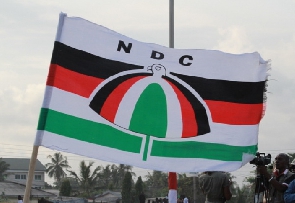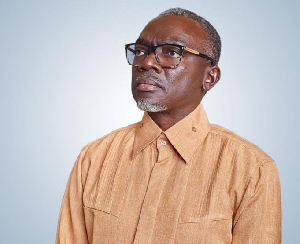The government of Ghana is on the right track to achieving macroeconomic stability, Dr Eric Osei-Assibey, Senior Adjunct Research Fellow with the Institute of Economic Affairs (IEA) has said.
Dr Osei-Assibey told journalists at a press conference on Thursday, 3 August that the Institute’s analysis of Finance Minister Ken Ofori-Atta’s mid-year budget presented to parliament recently shows that “most of the macro-indicators are moving in the right direction.”
“The challenge, however, is the sustainability of these gains which means more needs to be done in the areas of domestic revenue mobilisation and expenditure controls, adding that the government must also ensure sustainable debt management which largely borders on three critical factors: accelerating growth for base effect, closing fiscal gap to reduce the fiscal gap effect and ensuring exchange rate stability to control exchange risk and convertibility effect.
He also said there must be an increase in investment in growth-enhancing infrastructure and radical economic transformation to ensure export diversification.
Below is Dr Eric Osei-Assibey’s full statement:
KEY MACROECONOMIC PERFORMANCE AS AT JUNE 2017
According to the finance Minister, developments from January up to June 2017, indicate:
• The overall GDP for first quarter of 2017 grew by 6.6 percent against 4.4 percent for the same period in 2016; with end of year target maintained at 6.3 percent
• Inflation reduced to 12.1 percent at the end of June 2017, from 15.4 percent at end-December 2016; with end of year target maintained at 11.2 percent;
• Interest rates are on the decline. For example, the 91-day Treasury bill rates have reduced from 16.4 percent at end 2016 to 12.08 percent at end-June 2017.
• The fiscal deficit as a percentage of GDP for the period January-June 2017 was 2.7 percent compared with a deficit of 4.0 percent over the same period in 2016. However, the overall fiscal deficit has been revised downwards from 6.5 percent of GDP to 6.3 percent of GDP with a primary balance of a surplus of 0.2 percent of GDP;
• The primary surplus for January-June 2017 was 0.6 percent of GDP compared to a deficit of 1.3 percent over the same period in 2016; with end of year expected to record a surplus of 0.2 percent instead of the targeted 0.4 percent of GDP;
• The Gross International Reserves at the end of June 2017 was US$5.9 billion, the equivalent of 3.4 months of import cover, up from US$4.9 billion at the end of December 2016 (equivalent to 2.8 months of import cover). This is expected to reduce to at least 3 months of imports cover at end of 2017.
The minister also noted that in the Inter-Bank Market, the Ghana cedi depreciated on cumulative basis by 3.7 percent, 8.3 percent and 10.8 percent against the US dollar, the pound sterling and the euro respectively by end-June 2017.
Given these indicators, it is quite clear that government is making significant progress in stabilising the macro economy after a period of economic instability attributed to fiscal overruns in connection with the 2016 elections which resulted in government missing key macroeconomic targets such as inflation and fiscal deficit by a wide margin. Macroeconomic developments in 2017 point to a recovery in GDP growth, declining inflation, declining interest rates, narrowing fiscal gap, a relatively stable currency and increasing foreign exchange reserves. However, challenges and downside risk to fiscal sustainability and economic growth remain. In what follows, I discuss some of these key challenges and what needs to be done.
Real GDP Growth
Although the targeted growth of 6.3 percent is attainable, on the back of rising oil production and the benefits from macroeconomic stability, downside risk persists particularly from the non-oil sector growth. According to the Ghana Statistical service, in the first quarter of 2017 non-oil sector growth was weaker turning in at a modest 3.9 percent, against 6.3 percent recorded for the same period of last year (2016). Government projects 4.6 percent non-oil sector growth at the end of the year 2017. However, we think that the chances of missing this target is high because of the possible negative effects of government’s plan to cut expenditure by 1.1 percent of GDP from GH¢58.1 billion to GH¢55.9 billion. The key revisions include a cut in Capital expenditure by 0.3 percent of GDP and Good and Services by 0.4 percent of GDP.
Government expenditure on infrastructure in particular is a key driver of growth in the economy and a reduction in capital expenditure is likely to negatively impact on growth. Also, the delay in arrears clearance can reduce liquidity in the economy and slow economic activities. Another downside risk to growth is the halt in small scale mining activity (which is known to contribute about 15% to the total gold production). Although this may be marginal, it could have some negative effect on gold exports, foreign exchange earnings and ultimately impact on our growth projection for 2017.
Interest Rate and Credit Developments It was our expectation that the reduction in Monetary Policy Rate (MPR) from 25.5 percent to 21 percent over the last six months and the fall in Treasury Bill (TB) rates from 16.4 percent to 12.08 percent in the same period would cause banks to reduce their lending rates significantly. However, the average lending rate’s responsiveness to this significant reduction in MPR has been slow compared to periods when MPR is adjusted upwards. This situation has resulted in wider interest rate spreads in the country particularly between lending rate and MPR.
The high lending rate is inimical to economic growth as it inhibits private sector credit growth, and thereby constrains domestic investments and production expansion of the economy. The banks argue that the downward rigidity is due to the rising Non-performing loans and the fact that funding costs remain high which are already locked-in, and so until such time that these locked-in funds are retired, Ghanaians should not expect lending rates to fall.
We think this rationalisation is very lopsided and unfair to banks customers since these banks do not make the same argument when the MPR and TB rates are rising. One major underlying factor to the high lending rates in the country is the downward rigidity embedded in the formula for calculating the average base rate. We are aware that last year the Bank of Ghana constituted a technical committee to review the formula. However, the revised formula is yet to be adopted. We urge government to ensure a more transparent, flexible and competitively driven interest rate determination in the banking sector. This should not be limited to mainstream commercial banks only but also non-bank financial institutions including the saving and loans companies and microfinance institutions which even quote much higher lending rates. If these steps are not taken, government’s efforts at bringing interest rates down will not have the desired impact on the real sector of the economy. The combined effect of delays in settling arrears and the government’s new directive which enjoins all public institutions to transfer public sector deposits and cash assets from commercial banks into a Treasury Single Account (TSA), can pose a serious liquidity constraint to the banking sector and affect their ability to give credit to private sector businesses. Although the introduction of the TSA as a measure to control public spending and leakages is laudable, government should find ways of mitigating the effect of this initiative on the banking sector.
Fiscal Developments
IEA applauds government’s commitment to fiscal consolidation and its efforts to ensure fiscal and debt sustainability; particularly for aligning expenditures with realised revenues. The overall fiscal deficit for the first half of the year was 2.7 percent of GDP against a target of 3.5 percent while the year is expected to close at 6.3 percent instead of the targeted 6.5 percent. However, weak domestic revenue mobilisation remains the biggest threat to the attainment of this fiscal target. The 33 percent projection of revenue for the year was overambitious particularly looking at the volatile nature of the expected sources – international trade taxes and corporate income tax.
Also it is expected that various government tax initiatives would take time for the economy to achieve the desired gains. Although government has revised downward its revenue projection for the second half of the year, we believe that government may still not realise the projected revenue as the above challenges remain. Government should therefore pursue a more aggressive domestic tax revenue mobilisation by ensuring that the compliance rate is increased substantially and the loopholes within the tax collection system are plucked. Much more innovation should be introduced in the tax collection system particularly within the informal economy to reduce cost of collection and evasion. We also welcome government’s decision to implement IEA’s recommendation of adopting a numerical fiscal rule aimed at introducing fiscal discipline in the economy.
The minister in his presentation stated that “government has taken a decision to introduce a numerical fiscal rule to guide the implementation of fiscal policy. In this regard, we will bring to this house an amendment to the PFMA to limit the fiscal deficit within a range of 3 to 5 percent of GDP for any fiscal year”. Indeed the IEA has advocated for fiscal rule for years and we are happy to know the government intends to enshrine this in our laws.
Debt Overhang Issues
The government has indicated that it is likely to end the year 2017 with a debt to GDP ratio of 71%, about a two percentage point reduction of what was recorded last year (2016). Despite the debt management efforts by government, we think that the debt stock is still very high and unsustainable. The International Monetary Fund noted in the 2017 spring meeting that Ghana remains at a high risk of debt distress, which has implication for its creditworthiness and borrowing cost.
We commend government for the debt re-profiling initiative that is aimed at minimising cost and maintaining a prudent degree of risk while helping to develop the domestic capital market. However, while the increasing participation of non-resident investors in the domestic bond market is laudable, particularly the foreign currency inflows that they bring to shore-up the reserve buffer, we think that it has to be managed in order not to over expose the economy to external shocks such as sudden withdrawals that can impact negatively on exchange rate stability.
Moreover, government should ensure that the plan to clear the energy debt/arrears owed by energy utilities through the sale of a 10 billion cedi ($2.3 billion) local-currency bond, will not lead to increase in the public debt stock. Although government has said it intends to do this through a special purpose vehicle, it is still not clear in which books this debt will sit. We also encourage government to aggressively pursue the non-debt infrastructure financing initiative that is aimed at leveraging our untapped natural resources to bring private capital to finance major infrastructure projects.
Free Senior High School
Government has indicated its readiness to begin the implementation of the Free Senior High School (Free SHS) Policy in September this year. We believe that free and all inclusive educational system is a major driver and indeed a catalyst for sustainable growth and development. Successful implementation of this initiative will not only ensure equity in the educational system but also have positive multiplier effect in all sectors of the economy through a skilled and competent work-force.
However, we are concern about the sustainability of the financing source for this programme. The 2017 Budget indicates budgeted funding for the initiative to include GHC188.28 million (47%) - GoG, and GHC 211.72 million (53%) - ABFA. While this funding arrangement could introduce another level of rigidity in the budgeting system, the ABFA source of funding which contributes the major part of the total amount as we know is not stable but highly volatile. This is due to dynamics in the oil and gas industry; specifically relating to fluctuating oil prices which pose risk to sustainable funding for this initiative.
Given the important nature of this initiative for our country’s sustainable development, we are therefore calling on government to revisit its funding arrangement for this important initiative. A national forum or stakeholder workshop on how to ensure sustainable financing for the Free SHS programme in Ghana as a matter of urgency will be welcomed. We believe that a more sustainable funding should be pursued domestically. For example, just as we did for NHIS, increasing the VAT rate by say 1% and ringfencing it for exclusive funding of the Free SHS will be very ideal. Domestic tax revenue provides a more stable and predictable source of financing expenditure for important public programmes such as free education.
Concluding Remarks
In conclusion, we think that government is on track in achieving macroeconomic stability as most of the macro-indicators are moving in the right direction. The challenge however is the sustainability of these gains which means more needs to be done in the following areas:
• Aggressive domestic revenue mobilisation effort;
• Expenditure controls;
• Ensuring Sustainable Debt management: Achieving debt sustainability largely bothers on three critical factors; accelerating growth for base effect, closing fiscal gap to reduce the fiscal gap effect and ensuring exchange rate stability to control exchange risk and convertibility effect;
• Increase investment in growth-enhancing infrastructure; and
• Radical economic transformation to ensure export diversification
Finally, we also wish to commend government for introducing the Fiscal Responsibility Act, which has become increasingly a common tool to enhance fiscal prudence and public expenditure transparency in many countries.
However, the lack of monitoring and enforcement institutions to safeguard fiscal discipline and enforce adherence to such fiscal rules remains a problem. We will therefore urge government on to make good its promise of establishing an independent fiscal council that will among other things independently assess government fiscal forecasts and ensure compliance to fiscal rules
Business News of Thursday, 3 August 2017
Source: classfmonline.com

















